 Hoy thot, literally 'fried oysters', is one of the more emblematic Thai street hawker dishes. Consisting of mussels (or oysters) fried with egg in a batter of rice and mung bean flours, and served on a bed of soft bean sprouts, its simple, rustic nature lends itself to streets and stalls, and you'll rarely find the dish in any indoor restaurant.
Hoy thot, literally 'fried oysters', is one of the more emblematic Thai street hawker dishes. Consisting of mussels (or oysters) fried with egg in a batter of rice and mung bean flours, and served on a bed of soft bean sprouts, its simple, rustic nature lends itself to streets and stalls, and you'll rarely find the dish in any indoor restaurant.
Hoy Thot Chao Ley, a longstanding vendor of the dish on trendy Thanon Thong Lo, has compromised somewhat on hoy thot's streetside status. Located in a covered alleyway, the place almost gives the impression of being indoors, but in keeping with the dish's street origins, the hoy thot here is simple, tasty, crispy and satisfying. Admittedly, the dishes aren't rich or expertly-prepared as those of Nay Mong, but are better than most you'll find around town, and are worth checking out.
In addition hoy thot, pictured above, which incidentally they call hoy malaengphu thot krob ('crispy fried mussels'), they also do thaley thot krob (a seafood version that includes shrimp and squid), phat Thai, or suan (a soft oyster omelet) and or lua (crispy oyster omelet).
All of these dishes are prepared on a vast round skillet:
and are a lot less oily/greasy than you'd expect.
I'm heading up to Chiang Mai tonight and will be quiet for a few days, but hope to come back with some posts on northern food.
Hoy Thot Chao Ley Soi 55 (Thanon Thong Lo), Thanon Sukhumvit 085 128 3996 9am-9pm
View Thai Eats in a larger map




















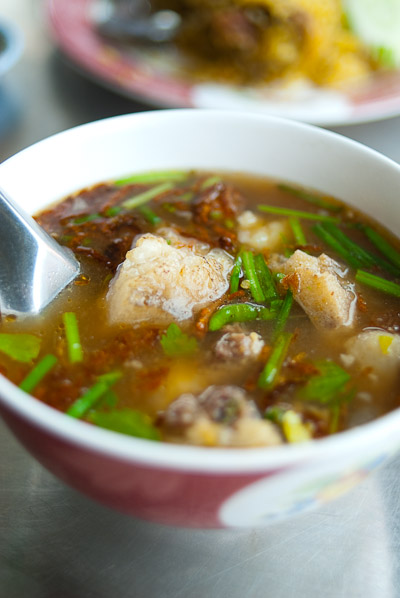







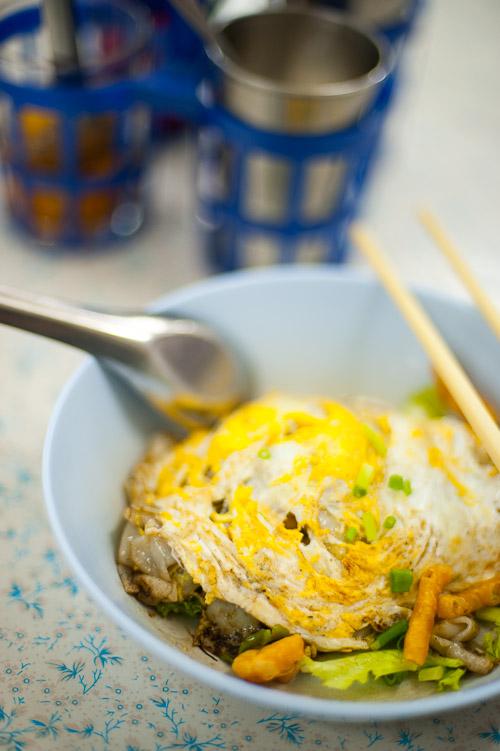
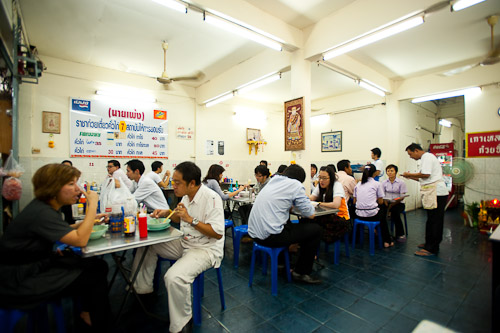
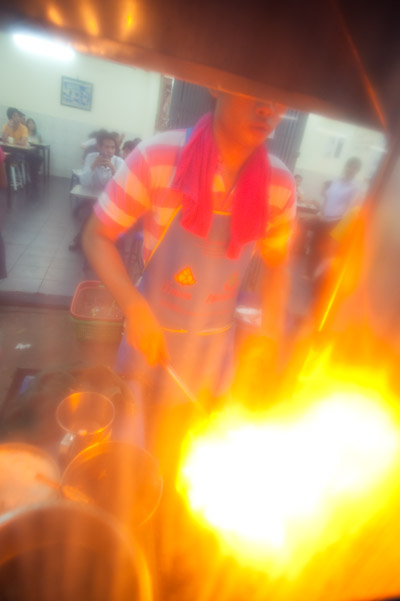



 First of all, allow me to apologise for not having blogged for such a long time. I had back surgery in early July and since then have been recovering, admittedly with enough time to blog, but unfortunately little in the way of content or desire. I’m more or less mobile now and am ready to jump...er carefully lower myself back into blogging again.
First of all, allow me to apologise for not having blogged for such a long time. I had back surgery in early July and since then have been recovering, admittedly with enough time to blog, but unfortunately little in the way of content or desire. I’m more or less mobile now and am ready to jump...er carefully lower myself back into blogging again.



 Sawang is a decades-old bamee (wheat and egg noodles) joint virtually across the street from Bangkok's Hualamphong Train Station. It's easily located by its overabundance of florescent green lighting and the aged and rather grumpy owner who sits in a chair out front. Some aged promotional material inside desribes Sawang as "The most expensive bamee in Thailand." Yet despite these ominous attributes, it's now my favourite place in town to eat the dish.
Sawang is a decades-old bamee (wheat and egg noodles) joint virtually across the street from Bangkok's Hualamphong Train Station. It's easily located by its overabundance of florescent green lighting and the aged and rather grumpy owner who sits in a chair out front. Some aged promotional material inside desribes Sawang as "The most expensive bamee in Thailand." Yet despite these ominous attributes, it's now my favourite place in town to eat the dish.


 Jay So originally comes from Yasothon, if I remember correctly, and opened her eponymous northeastern Thai restaurant in Bangkok's Silom area more than a decade ago. She's cheeky and boisterous, and eating at her place, with the smell of plaa raa (fermented fish) and the sound of the northeastern Thai dialect being spoken, is probably not unlike eating at restaurant in her home province. I've been eating here for years, and despite not having been back in a long while, she still somehow remembered that I like my som tam without sugar.
Jay So originally comes from Yasothon, if I remember correctly, and opened her eponymous northeastern Thai restaurant in Bangkok's Silom area more than a decade ago. She's cheeky and boisterous, and eating at her place, with the smell of plaa raa (fermented fish) and the sound of the northeastern Thai dialect being spoken, is probably not unlike eating at restaurant in her home province. I've been eating here for years, and despite not having been back in a long while, she still somehow remembered that I like my som tam without sugar.




 Despite having many of the same culinary resources and origins as neighbouring Thailand, the people of Laos subside on a markedly more basic diet. Considering Laos's poverty and lack of both infrastructure and large-scale agriculture, this shouldn't come as much of a surprise. But the monotony of the rural Lao diet can come as a shock if you've never encountered it personally.
Despite having many of the same culinary resources and origins as neighbouring Thailand, the people of Laos subside on a markedly more basic diet. Considering Laos's poverty and lack of both infrastructure and large-scale agriculture, this shouldn't come as much of a surprise. But the monotony of the rural Lao diet can come as a shock if you've never encountered it personally. 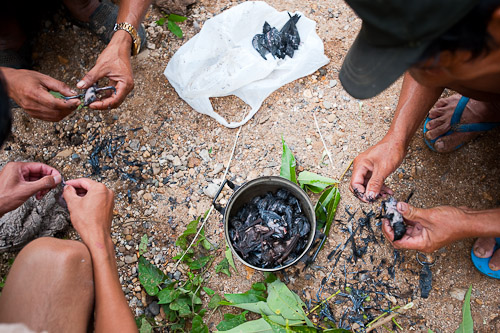
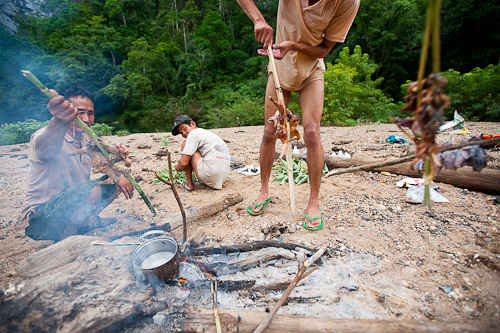
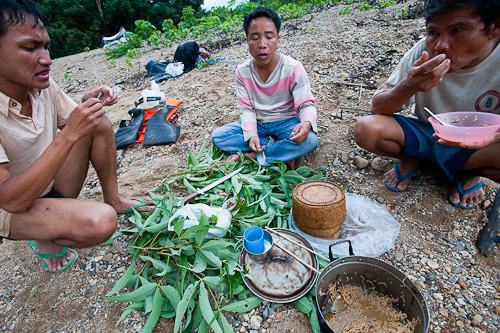

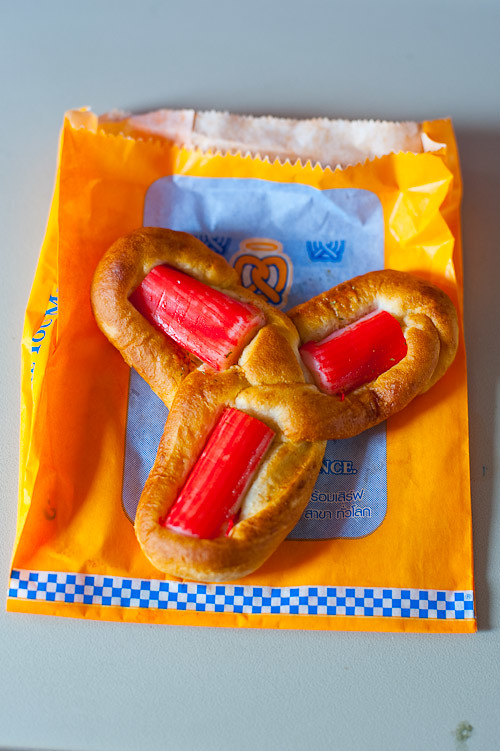 A three-pronged Auntie Anne's pretzel topped with hearty sticks of imitation crab. Encountered on a Nok Air flight from Bangkok to Nakhon Phanom. Resemblance to airplane propeller moderate, but edibility negligible.
A three-pronged Auntie Anne's pretzel topped with hearty sticks of imitation crab. Encountered on a Nok Air flight from Bangkok to Nakhon Phanom. Resemblance to airplane propeller moderate, but edibility negligible. Tanks crossing the barricade into the protesters' camp, Bangkok
Tanks crossing the barricade into the protesters' camp, Bangkok As mentioned
As mentioned 

 Damage and burning along Rama IV, Bangkok
Damage and burning along Rama IV, Bangkok I live just off of Thanon Silom, which in addition to being the area of Bangkok with arguably the most restaurants and street food, is also directly adjacent to the epicentre of
I live just off of Thanon Silom, which in addition to being the area of Bangkok with arguably the most restaurants and street food, is also directly adjacent to the epicentre of 

 Government soldier looks for snipers on Thanon Rama IV, Bangkok
Government soldier looks for snipers on Thanon Rama IV, Bangkok  Anti-government 'red shirt' protesters taunt soldiers, Rama IV, Bangkok
Anti-government 'red shirt' protesters taunt soldiers, Rama IV, Bangkok Locals cautiously watching the conflict unfolding on Rama IV, Bangkok
Locals cautiously watching the conflict unfolding on Rama IV, Bangkok Red shirt protesters stand their ground on Rama IV, Bangkok
Red shirt protesters stand their ground on Rama IV, Bangkok Red shirt protesters taunt soldiers, Rama IV, Bangkok
Red shirt protesters taunt soldiers, Rama IV, Bangkok Soldiers prepare to fire on red shirt protesters, Rama IV, Bangkok
Soldiers prepare to fire on red shirt protesters, Rama IV, Bangkok Red shirt protesters taunt soldiers on Thanon Rama IV
Red shirt protesters taunt soldiers on Thanon Rama IV  A violent confrontation between red shirt protesters and government soldiers along Rama IV
A violent confrontation between red shirt protesters and government soldiers along Rama IV  Soldiers preparing to fire at red shirt protesters on Thanon Rama IV
Soldiers preparing to fire at red shirt protesters on Thanon Rama IV  Soldiers firing an alleged mixture of rubber bullets, blanks and real bullets at protesters, Thanon Rama IV
Soldiers firing an alleged mixture of rubber bullets, blanks and real bullets at protesters, Thanon Rama IV  Captured red shirt protesters near Lumphini Boxing Statdium, Bangkok
Captured red shirt protesters near Lumphini Boxing Statdium, Bangkok Soldiers unrolling barbed wire along Rama IV, Bangkok. Smoking tires can be seen in the background.
Soldiers unrolling barbed wire along Rama IV, Bangkok. Smoking tires can be seen in the background.
 Locals look at burning tires on a bridge near Thanon Silom
Locals look at burning tires on a bridge near Thanon Silom 









